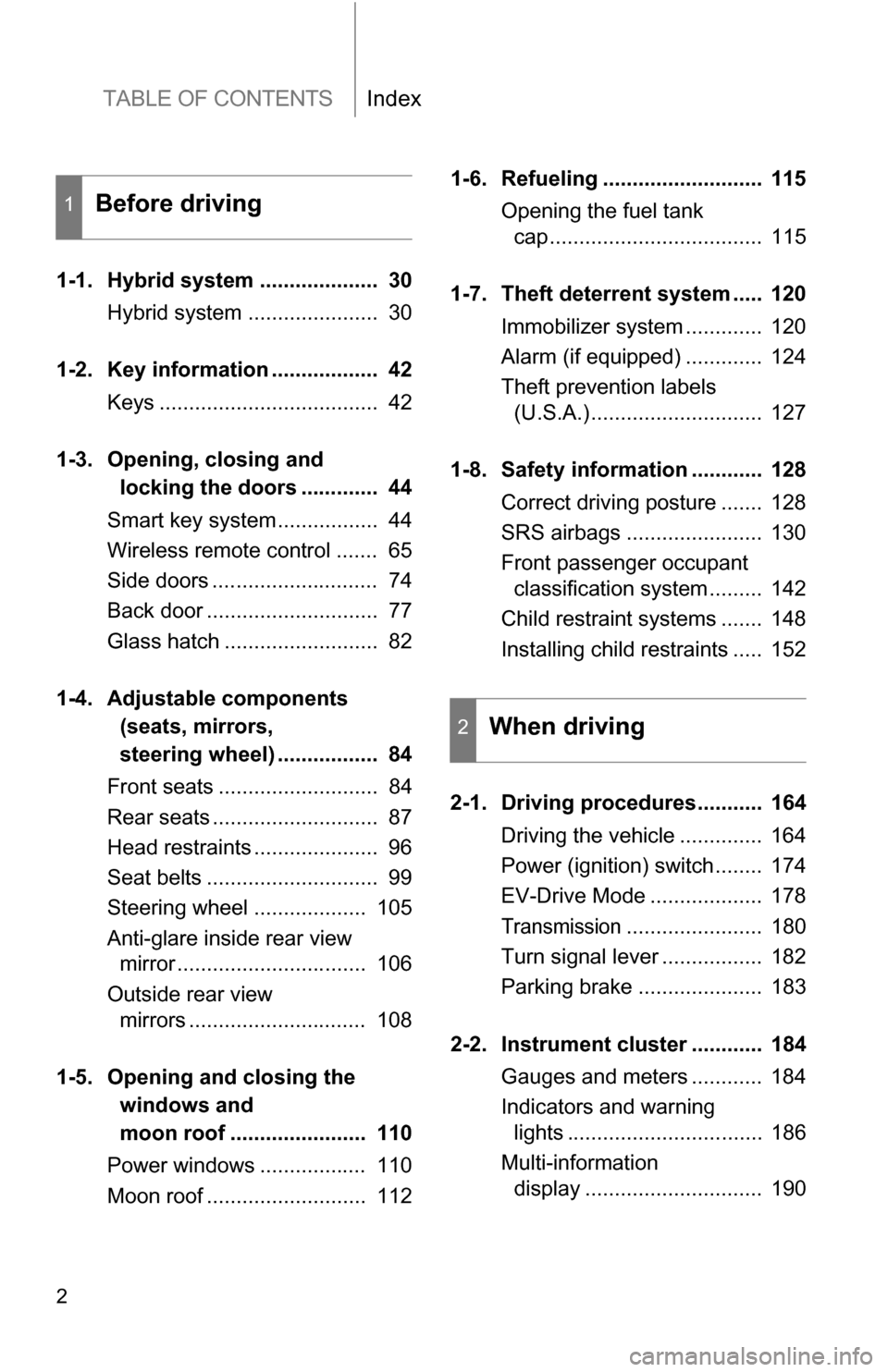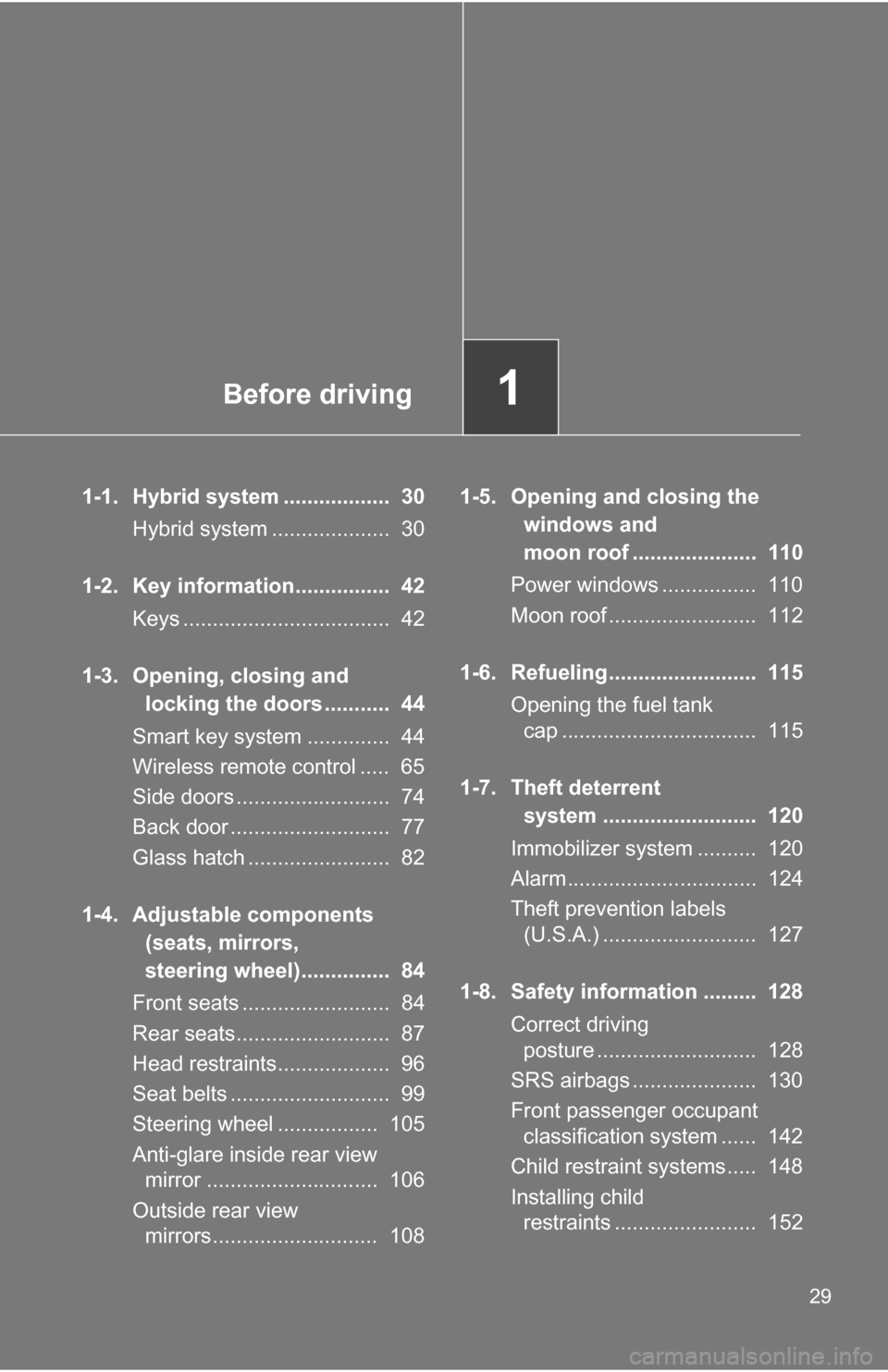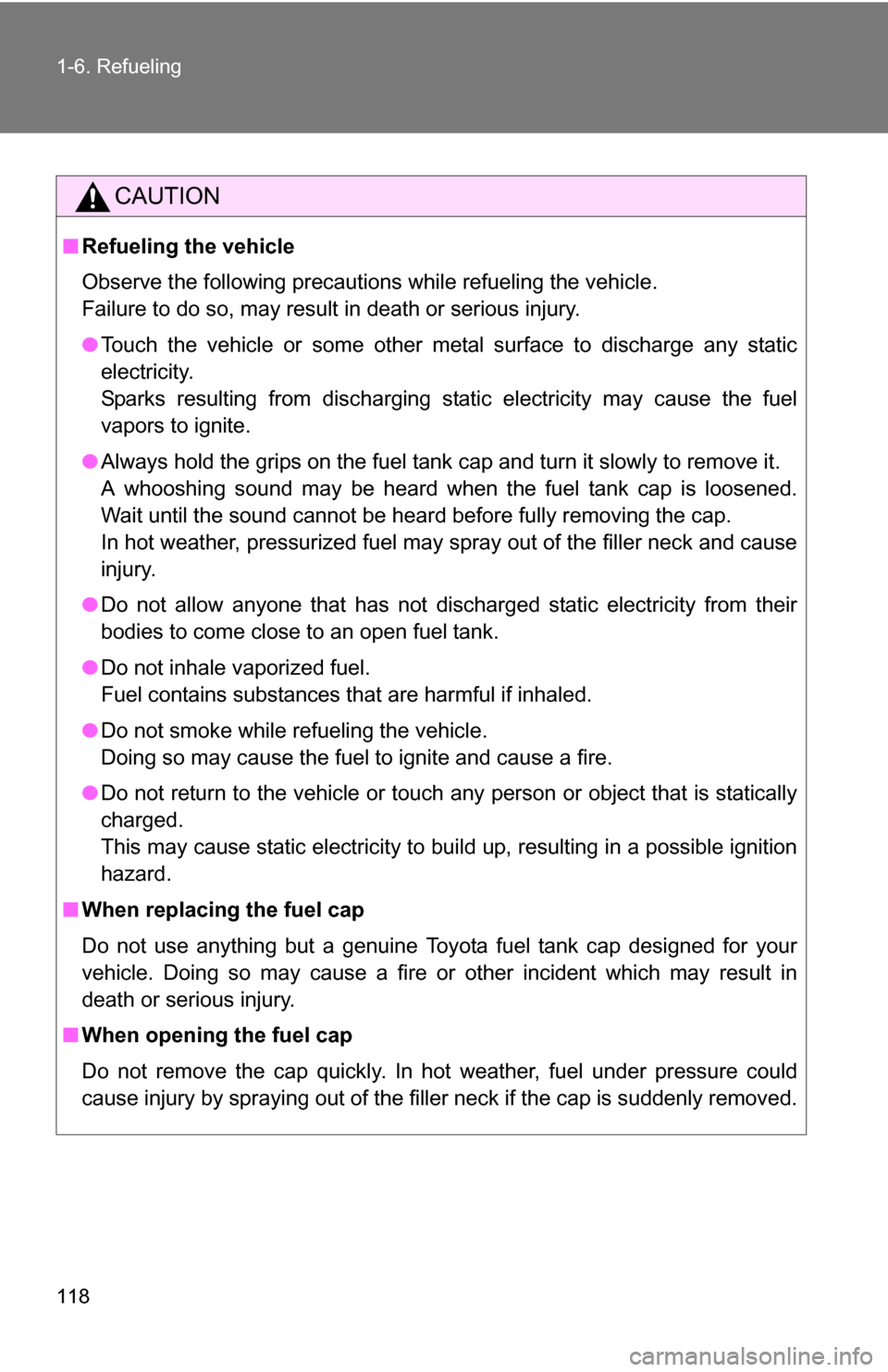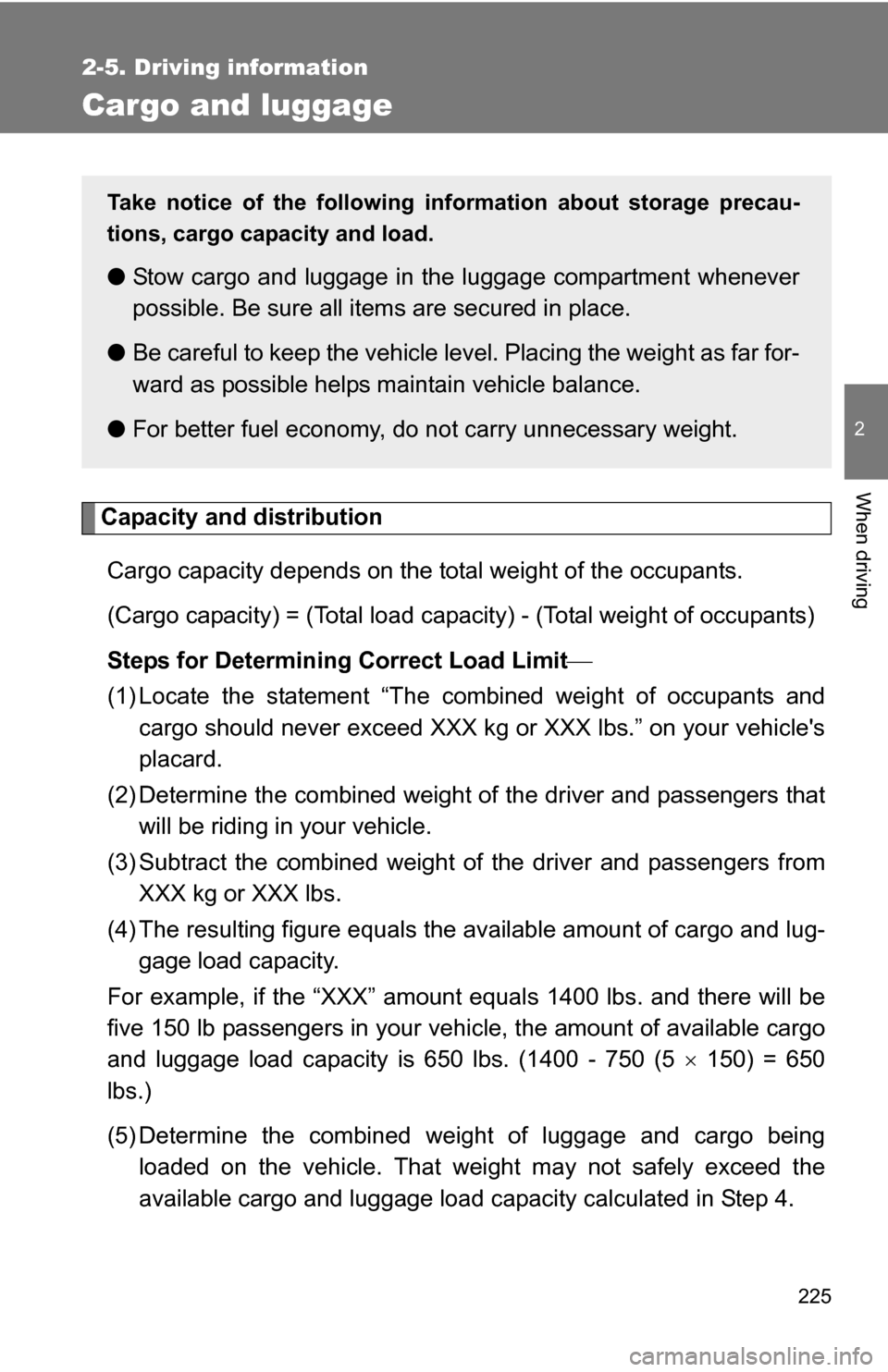Page 2 of 580

TABLE OF CONTENTSIndex
2
1-1. Hybrid system .................... 30Hybrid system ...................... 30
1-2. Key information .................. 42 Keys ..................................... 42
1-3. Opening, closing and locking the doors ............. 44
Smart key system................. 44
Wireless remote control ....... 65
Side doors ............................ 74
Back door ............................. 77
Glass hatch .......................... 82
1-4. Adjustable components (seats, mirrors,
steering wheel) ................. 84
Front seats ........................... 84
Rear seats ............................ 87
Head restraints ..................... 96
Seat belts ............................. 99
Steering wheel ................... 105
Anti-glare inside rear view mirror ................................ 106
Outside rear view mirrors .............................. 108
1-5. Opening and closing the windows and
moon roof ....................... 110
Power windows .................. 110
Moon roof ........................... 112 1-6. Refueling ........................... 115
Opening the fuel tank cap .................................... 115
1-7. Theft deterrent system ..... 120 Immobilizer system ............. 120
Alarm (if equipped) ............. 124
Theft prevention labels (U.S.A.)............................. 127
1-8. Safety information ............ 128 Correct driving posture ....... 128
SRS airbags ....................... 130
Front passenger occupant classification system ......... 142
Child restraint systems ....... 148
Installing child restraints ..... 152
2-1. Driving procedures........... 164 Driving the vehicle .............. 164
Power (ignition) switch........ 174
EV-Drive Mode ................... 178
Transmission....................... 180
Turn signal lever ................. 182
Parking brake ..................... 183
2-2. Instrument cluster ............ 184 Gauges and meters ............ 184
Indicators and warning lights ................................. 186
Multi-information display .............................. 190
1Before driving
2When driving
Page 29 of 580

Before driving1
29
1-1. Hybrid system .................. 30Hybrid system .................... 30
1-2. Key information................ 42 Keys ................................... 42
1-3. Opening, closing and locking the doors ........... 44
Smart key system .............. 44
Wireless remote control ..... 65
Side doors .......................... 74
Back door ........................... 77
Glass hatch ........................ 82
1-4. Adjustable components (seats, mirrors,
steering wheel)............... 84
Front seats ......................... 84
Rear seats.......................... 87
Head restraints................... 96
Seat belts ........................... 99
Steering wheel ................. 105
Anti-glare inside rear view mirror ............................. 106
Outside rear view mirrors............................ 108 1-5. Opening and closing the
windows and
moon roof ..................... 110
Power windows ................ 110
Moon roof ......................... 112
1-6. Refueling......................... 115 Opening the fuel tank cap ................................. 115
1-7. Theft deterrent system .......................... 120
Immobilizer system .......... 120
Alarm................................ 124
Theft prevention labels (U.S.A.) .......................... 127
1-8. Safety information ......... 128 Correct driving posture ........................... 128
SRS airbags ..................... 130
Front passenger occupant classification system ...... 142
Child restraint systems..... 148
Installing child restraints ........................ 152
Page 115 of 580
115
1
Before driving
1-6. Refueling
Opening the fuel tank cap
The fuel tank of your vehicle has a special structure, which requires
a reduction in fuel tank pressure before refueling. After the opener
switch has been pressed, it will take several seconds until the vehi-
cle is ready for refueling.
■ Before refueling the vehicle
Turn the “POWER” switch to OFF and ensure that all the doors
and windows are closed.
■ Opening the fuel tank cap
Press the fuel filler door
opener switch.
When the message “REFUEL
READY” appears, the fuel filler
door will open.
Turn the fuel tank cap slowly
to open.
STEP1
STEP2
Page 116 of 580
116 1-6. Refueling
Closing the fuel tank capWhen replacing the fuel tank
cap, turn it until a clicking sound
is heard.
After releasing your hand, the cap
will turn slightly to the opposite
direction.
Hang the fuel tank cap on the
back of the fuel filler door.STEP3
■Fuel types
Use unleaded gasoline. (87 Octane rating [Research Octane Number 91] or
higher)
■ Fuel tank capacity
Approximately 17.2 gal. (65.0 L, 14.3 Imp. gal.)
■ If the fuel filler door does no t open and a “PLEASE WAIT NOW
OPENING” message appears on th e multi-information display
Fuel tank pressure is being reduced. The fuel filler door will open within
about 10 seconds of the switch being pressed.
Page 117 of 580
117
1-6. Refueling
1
Before driving
■
If the fuel filler door opener is inoperable
If the fuel filler door opener switch cannot be operated, contact your Toyota
dealer. In the event that urgent refueling is required, follow the procedure
below.
Remove the cap slowly. Take care to prevent fuel from spilling out,
as fuel tank pressure may not have been adequately reduced.
Fill the fuel tank carefully and slowly. Use caution, as air being dis-
charged from inside the fuel tank may cause fuel to spray out from
the filler opening during refueling.
Open the fuel filler door using the lever in
the luggage compartment.STEP1
STEP2
STEP3
Page 118 of 580

118 1-6. Refueling
CAUTION
■Refueling the vehicle
Observe the following precautions while refueling the vehicle.
Failure to do so, may result in death or serious injury.
●Touch the vehicle or some other metal surface to discharge any static
electricity.
Sparks resulting from discharging static electricity may cause the fuel
vapors to ignite.
● Always hold the grips on the fuel tank cap and turn it slowly to remove it.
A whooshing sound may be heard when the fuel tank cap is loosened.
Wait until the sound cannot be heard before fully removing the cap.
In hot weather, pressurized fuel may spray out of the filler neck and cause
injury.
● Do not allow anyone that has not discharged static electricity from their
bodies to come close to an open fuel tank.
● Do not inhale vaporized fuel.
Fuel contains substances that are harmful if inhaled.
● Do not smoke while refueling the vehicle.
Doing so may cause the fuel to ignite and cause a fire.
● Do not return to the vehicle or touch any person or object that is statically
charged.
This may cause static electricity to build up, resulting in a possible ignition
hazard.
■ When replacing the fuel cap
Do not use anything but a genuine Toyota fuel tank cap designed for your
vehicle. Doing so may cause a fire or other incident which may result in
death or serious injury.
■ When opening the fuel cap
Do not remove the cap quickly. In hot weather, fuel under pressure could
cause injury by spraying out of the filler neck if the cap is suddenly removed.
Page 119 of 580
119
1-6. Refueling
1
Before driving
NOTICE
■
Refueling
●Finish refueling within 30 minutes. If more than 30 minutes passes, the
internal valve closes. In this condition, fuel may spill out if you continue to
refuel the vehicle. About 5 minutes after the valve is closed, a message
“CLOSE FUEL LID” will appear on the multi-information display. To refuel
the vehicle again, tighten the fuel tank cap and close the fuel filler door,
and then push the fuel filler door opener switch again.
● Do not spill fuel during refueling.
Doing so may damage the vehicle, such as causing the exhaust systems
to operate abnormally or damaging fuel system components or the vehi-
cle's painted surface.
Page 225 of 580

225
2-5. Driving information
2
When driving
Cargo and luggage
Capacity and distributionCargo capacity depends on the total weight of the occupants.
(Cargo capacity) = (Total load capacity) - (Total weight of occupants)
Steps for Determining Correct Load Limit
(1) Locate the statement “The co mbined weight of occupants and
cargo should never exceed XXX kg or XXX lbs.” on your vehicle's
placard.
(2) Determine the combined weight of the driver and passengers that will be riding in your vehicle.
(3) Subtract the combined weight of the driver and passengers from XXX kg or XXX lbs.
(4) The resulting figure equals the av ailable amount of cargo and lug-
gage load capacity.
For example, if the “XXX” amount equals 1400 lbs. and there will be
five 150 lb passengers in your vehicle, the amount of available cargo
and luggage load capacity is 650 lbs. (1400 - 750 (5 150) = 650
lbs.)
(5) Determine the combined weight of luggage and cargo being loaded on the vehicle. That weight may not safely exceed the
available cargo and luggage load capacity calculated in Step 4.
Take notice of the following information about storage precau-
tions, cargo capacity and load.
●Stow cargo and luggage in the luggage compartment whenever
possible. Be sure all item s are secured in place.
● Be careful to keep the vehicle level. Placing the weight as far for-
ward as possible helps maintain vehicle balance.
● For better fuel economy, do no t carry unnecessary weight.